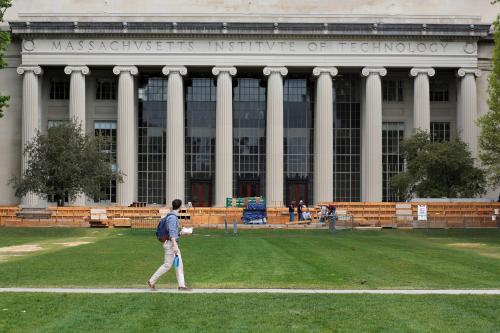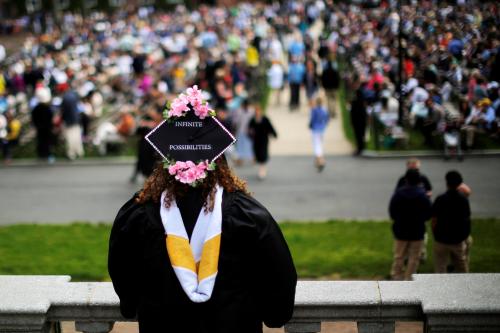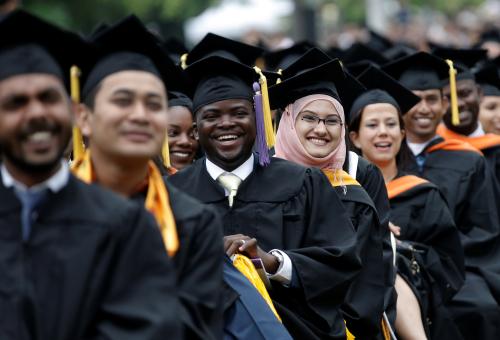There is not very much to like about the Tax Cuts and Jobs Act of 2017. It delivers big benefits to the affluent, creates new loopholes and complexities, and will send the deficit soaring. One provision with some merit, however, is the introduction of a tax on the endowments of wealthy colleges.
Of course, it has hardly gone down well within the Ivy League. But there are some hard truths to face here. A small handful of elite universities have aggressively raised billions of dollars supported by tax-free endowments while increasing tuition costs and doing little to promote social mobility. The endowment tax should not simply be used to raid their funds. It should be used as a tool to incentivize colleges to become more inclusive. Less hoarding of both money and opportunity; more investments in upward mobility. If structured properly, the threat of taxation could be a force to create more opportunity for children from working families, not an offset to cut taxes for children of multi-millionaires.
the harvard hedge fund
Total student tuition paid to Harvard was just under $300 million, less than one percent of the size of their endowment. Harvard and other elite schools endowments pay more in management fees than they pay out in scholarships. Most people think of Harvard University as an educational institution. But from a distance it looks worryingly like a large hedge fund, operating a small university on the side in order to secure non-profit status. Harvard’s endowment is over $37 billion, more than 7 times as large as the university’s operating budget, and more than half the total spending each year by America’s 1,462 community colleges. Harvard’s highest paid employee, earning almost $15 million last year, is the manager of the endowment. (The top seven employees managing the endowment earned a total of $58 million between them).
The Big Four in terms of endowment size – Harvard, Yale, Stanford and Princeton – have fewer than one in five students receiving Pell Grant support.
This is not just an Ivy-covered issue. A similar logic could be applied to ask if other schools are simply professional football teams with larger non-profit arms. For example, the University of Alabama’s head football coach is paid more than $11 million a year; the University of Michigan’s received $7 million in 2017.
Of course, these institutions are not operating in a vacuum. They face a range of perverse incentives and market pressures, including college rankings that promote endowment growth at the cost of student aid. Endowment-to-student ratios are a common factor used in college rankings, resulting in “my endowment’s bigger than your endowment” arms race. The government student lending program provides little if any counter-balance.
The new small tax on endowments will not solve these problems. But it does serve as a wake-up call to higher education leaders: time to return to their core values of providing opportunity and enrichment for students. Properly applied, the tax could help to promote these values. Many colleges could do much more to attract and retain lower-income students with little impact on their endowment.
use an endowment tax as a stick – and a carrot
There is a strong case for public policies that encourage funds to be used on students, and especially on students from poorer backgrounds, rather than growing massive tax-free endowment funds. The Republicans, however, have not used tax reform to alter behavior or change incentives. They have simply gone for the money; with the political side-benefit of tweaking the noses of the learned liberals dominating the top ranks of elite college. To the GOP, college endowments are an ATM, with the money taken out given straight to corporations and the rich.
A better approach would be to use an endowment tax as a means for altering incentives in a pro-mobility direction. Rather than punishing all colleges with large endowments equally, the goal should be to reward those which are using their funds in an opportunity-enhancing way. The colleges who will face the new tax vary greatly in terms of the composition of their student bodies:
At one end of the spectrum is Berea College, a school that uses its endowment to provide free education for a diverse student body: two out of the three are the first in their family to attend college and 83 percent are Pell Grant recipients. Meanwhile the Big Four in terms of endowment size – Harvard, Yale, Stanford and Princeton – have fewer than one in five students receiving Pell Grant support.
In general, selective and elite colleges serve to reinforce existing social and economic inequalities, rather equalizing opportunities. The postsecondary education system as a whole plays an important role in the reproduction of inequality across generations. There is more dream hoarding than dream sharing going in most of our top colleges, whether they like to admit it or not.
We don’t propose here to set out a concrete policy proposal. But here are some possible avenues:
- Provide an exemption from or reduction in the endowment tax for colleges and universities who are working hard to promote opportunity. One option is to use a certain threshold for Pell-eligible students (say at least 33 percent); another would be to base a threshold on the Mobility Scorecards produced by the Equality of Opportunity Project.
- Keep the endowment tax, but dedicate all revenues to proven pro-mobility policies in post-secondary education, including scholarships, tutoring schemes or programs like CUNY’s ASAP, just successfully replicated in other sites.
- Exempt endowment gifts that are for explicitly inclusive purposes. A considerable chunk of the endowment funds are restricted to certain kinds of spending – usually at the request of a donor. Exempting pro-mobility endowment funding (eg. Dedicated to scholarships for low-income students or similar) from the tax could encourage a shift in the norms and behavior of donors.
- A reduction in the endowment tax could be offered to institutions who abandon unfair and anti-meritocratic practices such as admissions preferences for legacies or children of donors.
As we said, these are just food for thought. Our hope is that colleges impacted by the new tax will not simply rail against its injustice, or the evils of the Trump administration in general. That would play into Republican hands. Note that most Republican or Republican-leaning voters now think that colleges “have a negative effect on the way things are going in the country,” according to a 2017 Pew poll.
The leaders of our richest colleges and universities must do more than simply hunker down. There are valid criticisms of the way they are amassing and deploying their financial resources. A tougher version of the endowment tax from House Republicans was beaten back. But this isn’t over. Colleges would be wise to act now.








Commentary
New college endowment tax won’t help low-income students, here’s how it could
February 22, 2018